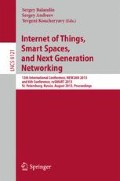Abstract
Data packets from different TCP (Transmission Control Protocol) flows, which are transferred over IP (Internet Protocol) networks, pass through the various links and through the different capacity router buffers on the way to the receivers. Most authors consider the size of the output buffer on the router that is connected to the rest of the network via bottleneck link, equal to bandwidth-delay product. In more recent studies, based on the assumption that TCP flows are desynchronized, much lower values are suggested. In this paper we analyse wireless last hop links with errors occurring during signal transmission. Established TCP flows are considered both synchronized and desynchronized. Also, reverse traffic is present. Simulations are made with different number of flows originating from different protocols. The obtained results show that proposed buffer size values do not correspond to the optimal ones. That is why we determine the optimal buffer sizes.
Access this chapter
Tax calculation will be finalised at checkout
Purchases are for personal use only
Preview
Unable to display preview. Download preview PDF.
References
Villamizar, C., Song, C.: High Performance TCP in ANSNET. ACM SIGCOMM Computer Communications Review 24(5), 45–60 (1994)
Appenzeller, G., Keslassy, I., McKeown, N.: Sizing Router Buffers. In: ACM SIGCOMM, Portland, OR, USA, pp. 281–292 (2004)
Wischik, D., McKeown, N.: Part I: Buffer Sizes for Core Routers. ACM SIGCOMM Computer Communications Review 35(2), 75–78 (2005)
Enachescu, M., Ganjali, Y., Goel, A., McKeown, N., Roughgarden, T.: Part III: Routers with Very Small Buffers. ACM SIGCOMM Computer Communications Review 35(2), 83–89 (2005)
Hassayoun, S., Ross, D.: Loss Synchronization and Router Buffer Sizing with High-Speed Versions of TCP. In: IEEE 34th Conference on Local Computer Networks, Zurich, Switzerland, pp. 569–576 (2009)
Stevens, W.: TCP Slow Start, Congestion Avoidance, Fast Retransmit, and Fast Recovery Algorithms. Request for Comments (RFC) 2001 (1997)
Brakmo, L.S., Peterson, L.L.: TCP Vegas: End to End Congestion Avoidance on a Global Internet. IEEE Journal on Selected Areas in Communication 13(8), 1465–1480 (1995)
Shifeng, X., Zehua, G., Feng, G., Nan, W., Ronghua, Z.: An Enhanced TCP Veno over Wireless Local Area Networks. In: 5th Int. Conf. on Wireless Communications, Networking and Mobile Computing, WiCOM 2009, Beijing, China, pp. 4038–4041 (2009)
Hwang, J.-H., Yoo, S.-H., Yoo, C.: TCP Feno: Enhancement for Higher Accuracy of Loss Differentiation over Small Buffer Heterogeneous Networks. In: IEEE 34th Conference on Local Computer Networks, Zürich, Switzerland, pp. 249–252 (2009)
Tian, Y., Xu, K., Ansari, N.: TCP in Wireless Environments: Problems and Solutions. IEEE (Radio) Communications Magazine 43(3), S27–S32 (2005)
Haßlinger, G., Hohlfeld, O.: The Gilbert-Elliott Model for Packet.Loss in Real Time Services on the Internet. In: Proc. 14th GI/ITG Conference on Measurement, Modeling, and Evaluation of Computer and Communication Systems (MMB), pp. 269–283 (2008)
Grieco, L.A., Mascolo, S.: Performance Evaluation and Comparison of Westwood+, New Reno, and Vegas TCP Congestion Control. ACM Computer Communications Review 34(2) (2004)
McCanne, S., Floyd, S.: Network Simulator ns2.31, http://www.isi.edu/nsnam/ns
Wei, D. X., Cao, P.: A Linux TCP Implementation for NS2, http://netlab.caltech.edu/projects/ns2tcplinux
Hwang, J.-H., Yoo, S.-H., Yoo, C.: TCP Feno Implementation for NS2, http://os.korea.ac.kr/research/research.html?title=feno
Floyd, S.: Metrics for the Evaluation of Congestion Control Mechanisms. IETF Internet-draft (2006)
Author information
Authors and Affiliations
Editor information
Editors and Affiliations
Rights and permissions
Copyright information
© 2013 Springer-Verlag Berlin Heidelberg
About this paper
Cite this paper
Vujović, I., Delibašić, M. (2013). Influence of Buffer Size on TCP Performance in Heterogeneous Wired/Wireless Networks. In: Balandin, S., Andreev, S., Koucheryavy, Y. (eds) Internet of Things, Smart Spaces, and Next Generation Networking. ruSMART NEW2AN 2013 2013. Lecture Notes in Computer Science, vol 8121. Springer, Berlin, Heidelberg. https://doi.org/10.1007/978-3-642-40316-3_20
Download citation
DOI: https://doi.org/10.1007/978-3-642-40316-3_20
Publisher Name: Springer, Berlin, Heidelberg
Print ISBN: 978-3-642-40315-6
Online ISBN: 978-3-642-40316-3
eBook Packages: Computer ScienceComputer Science (R0)

